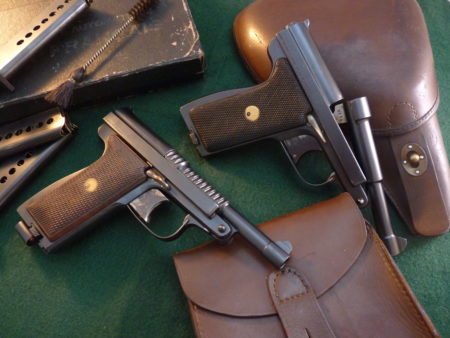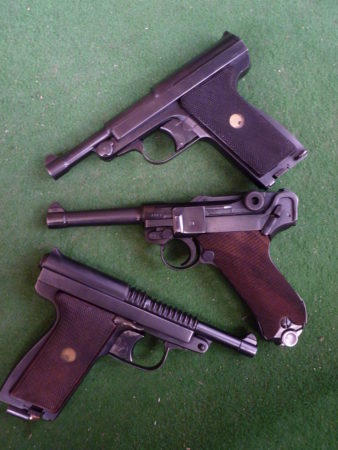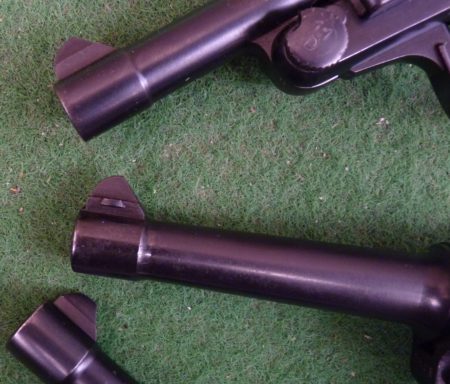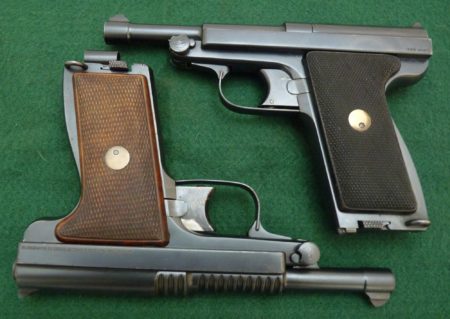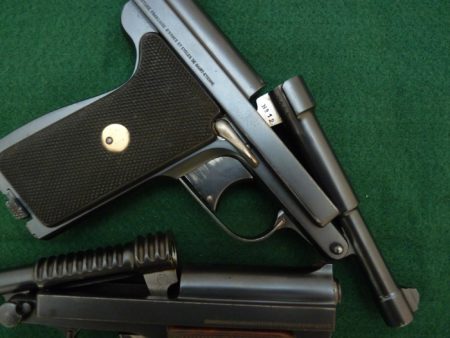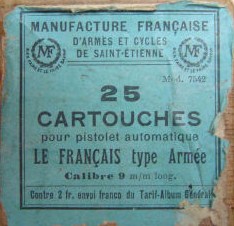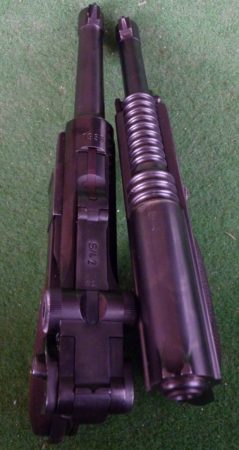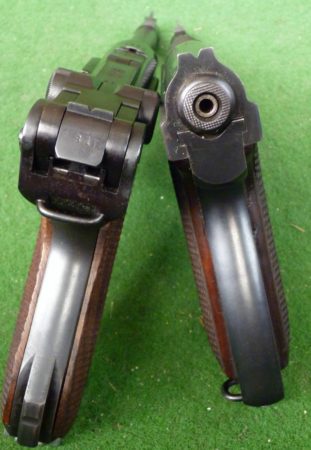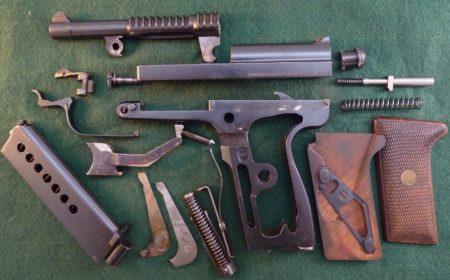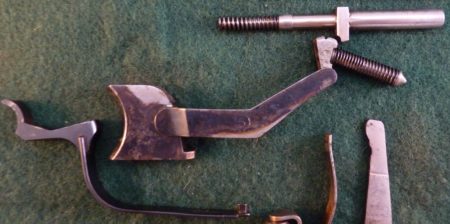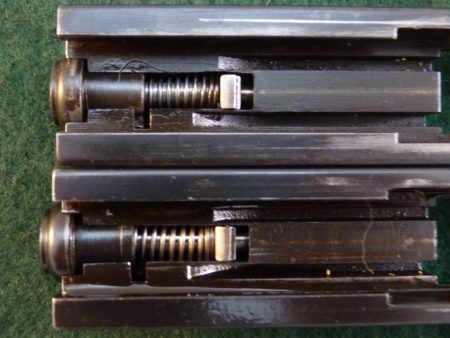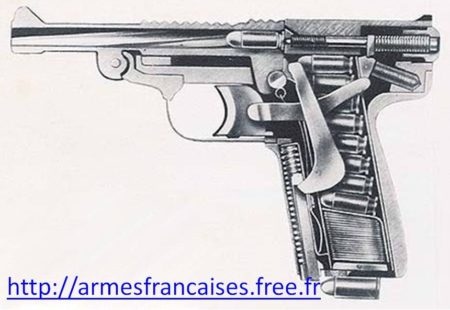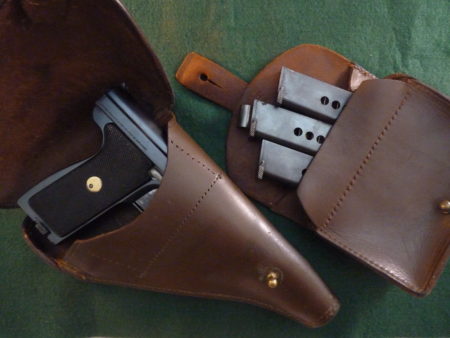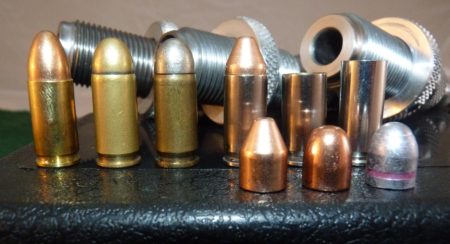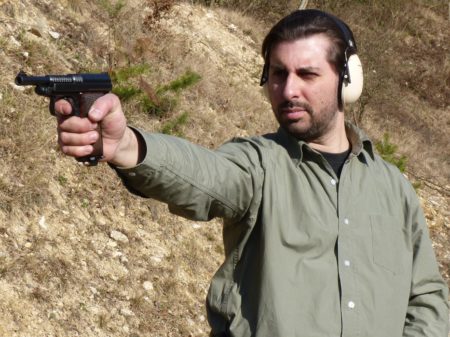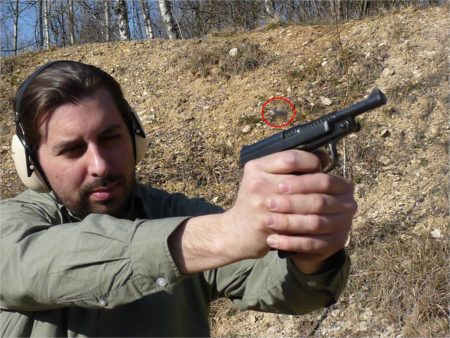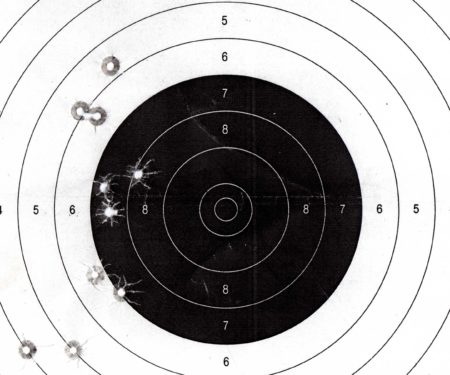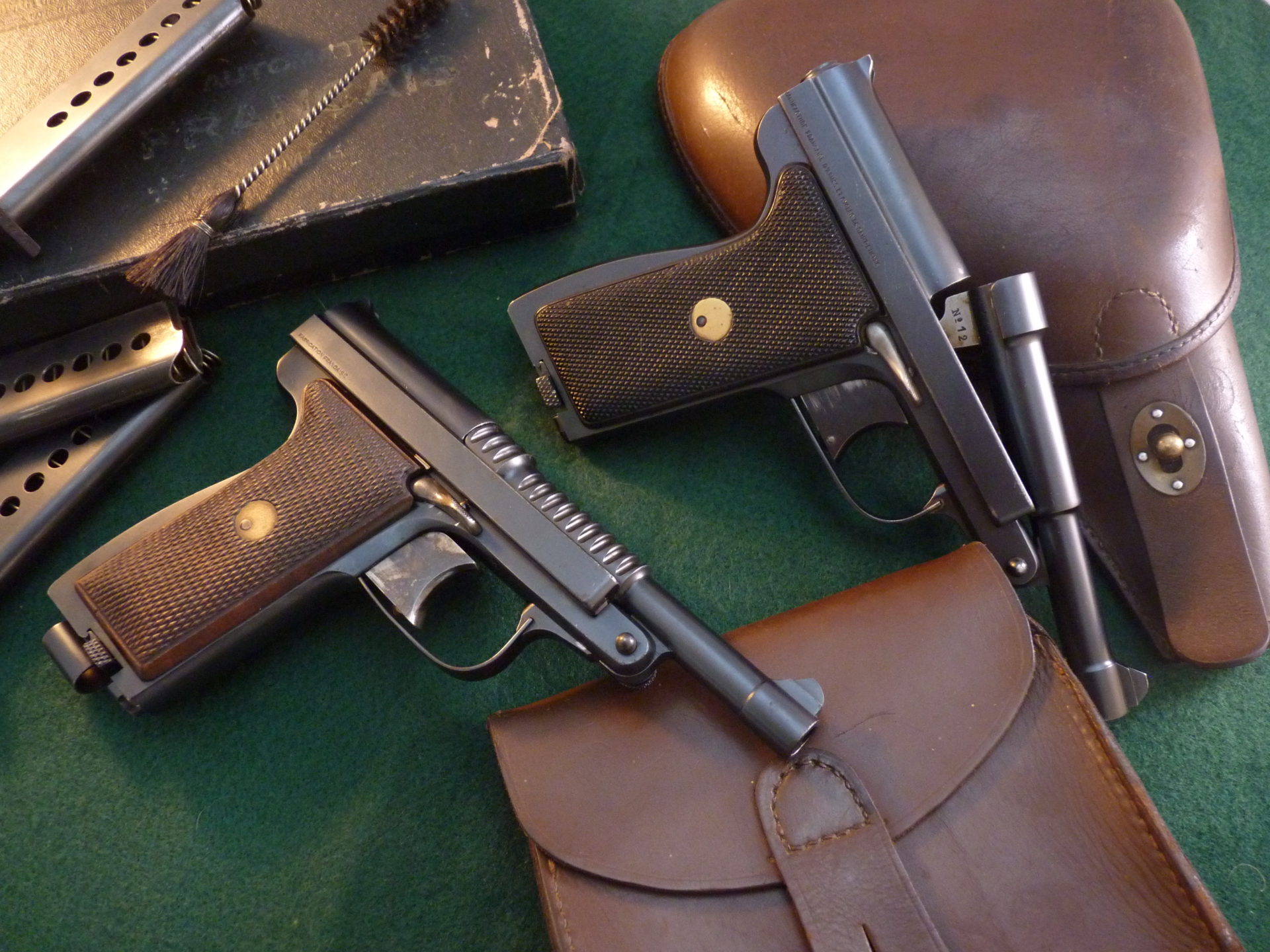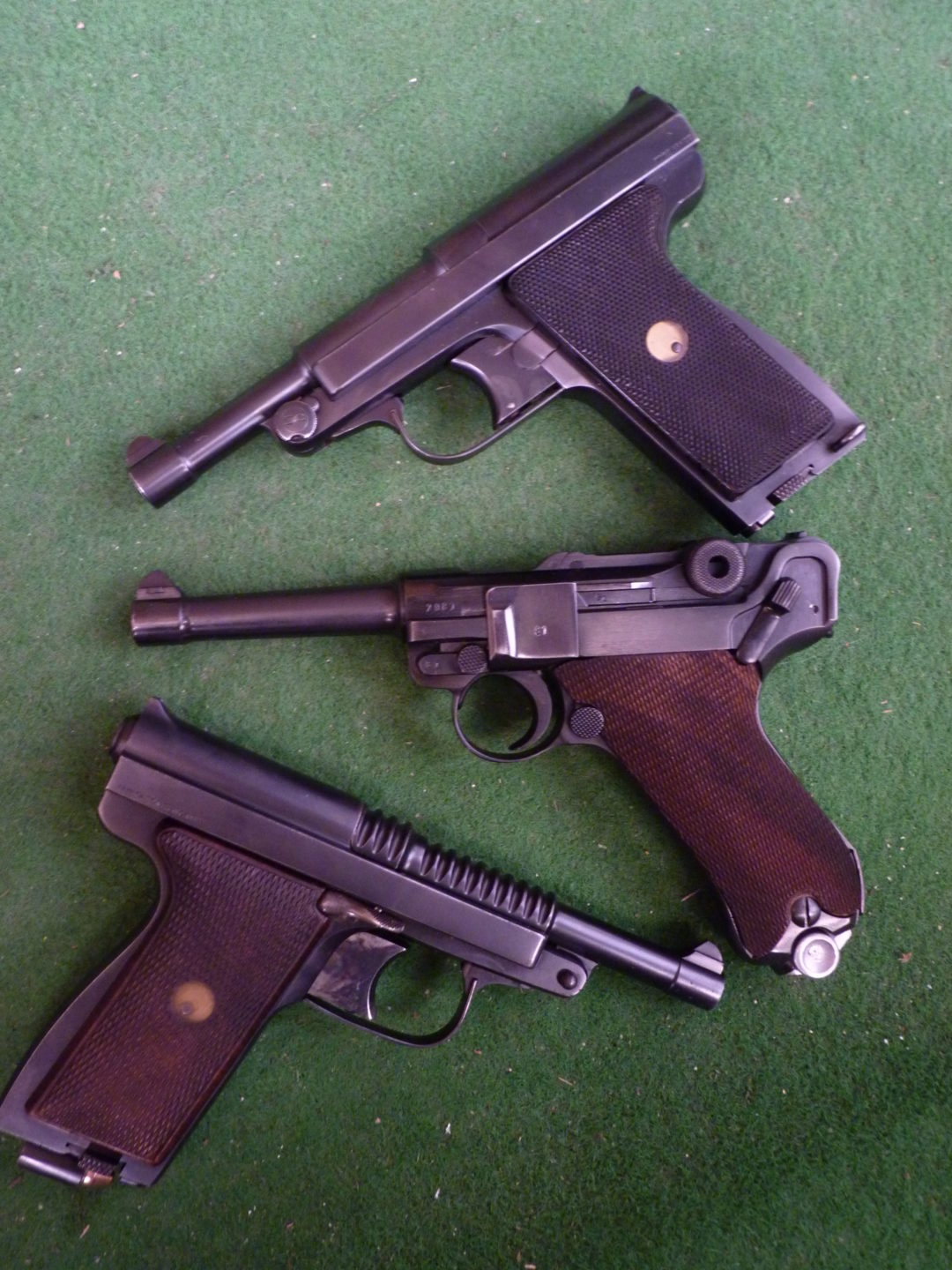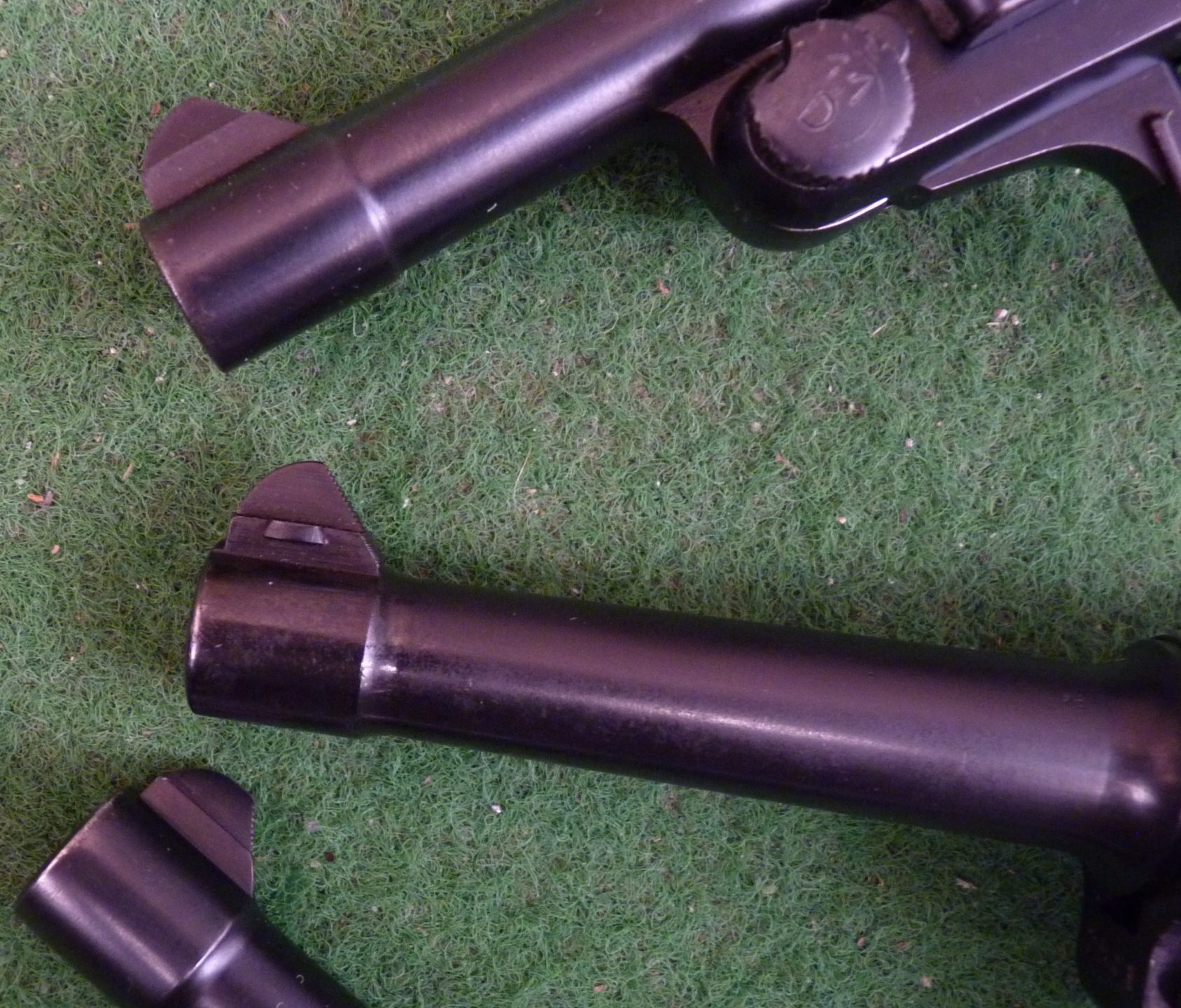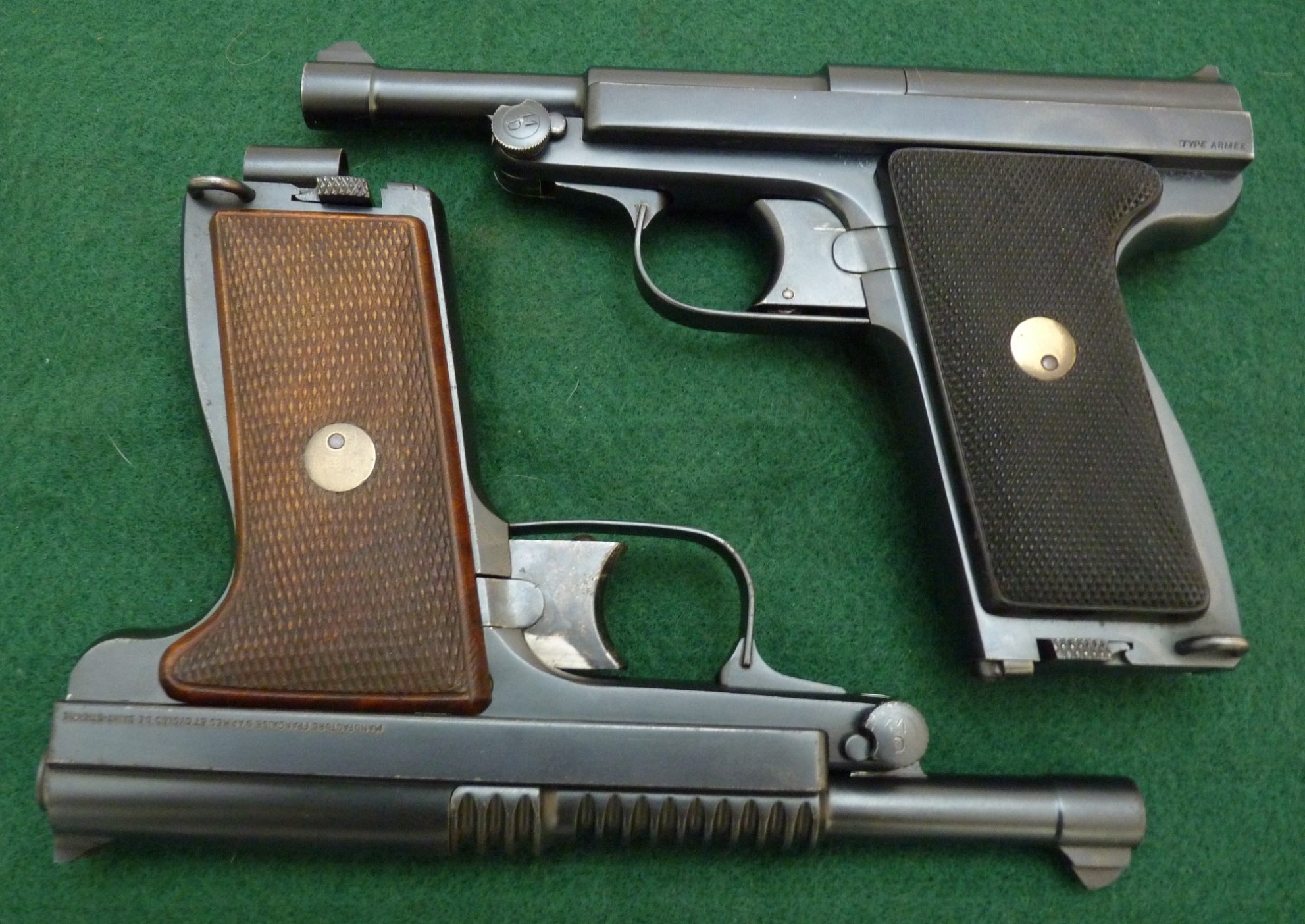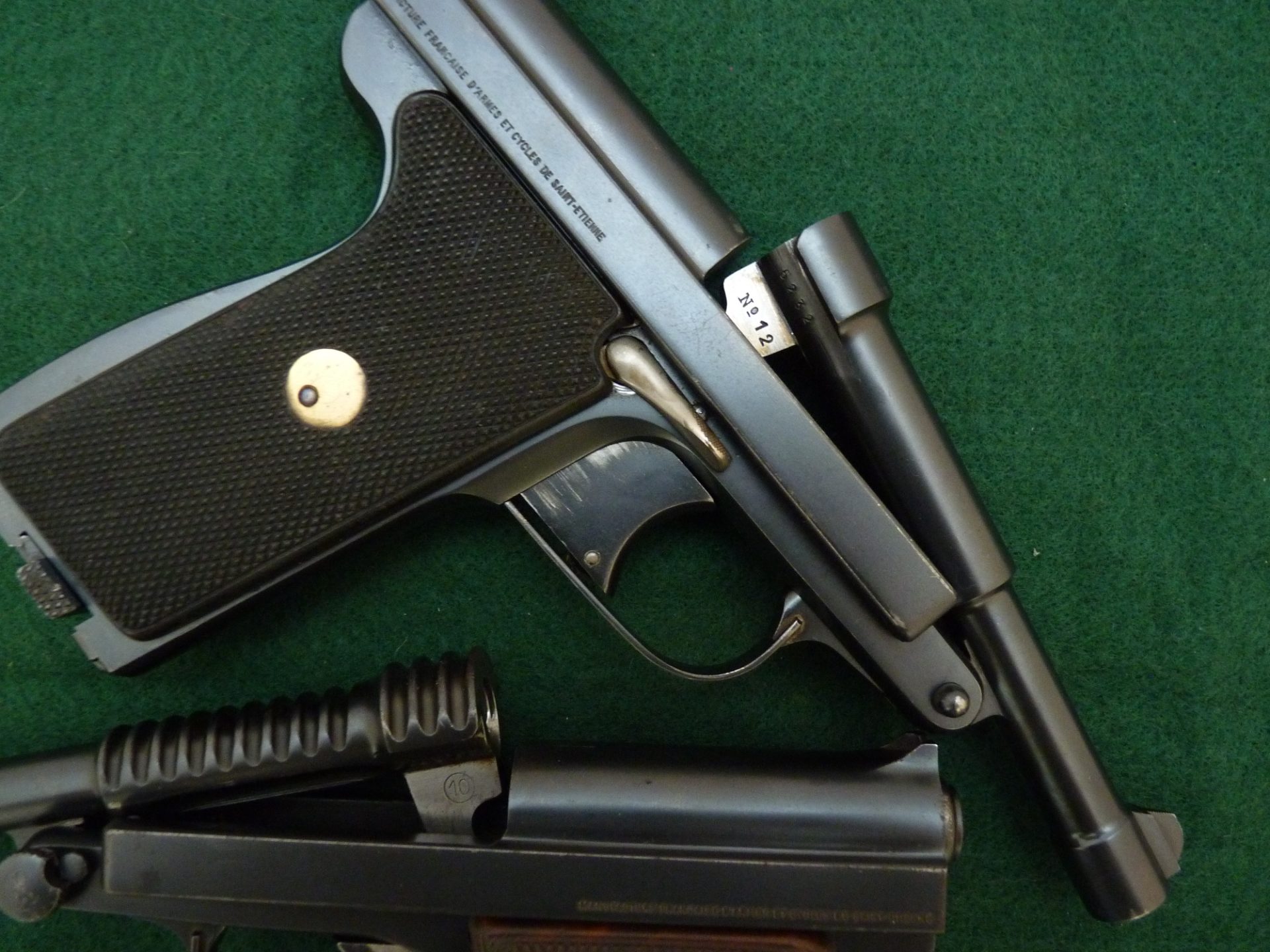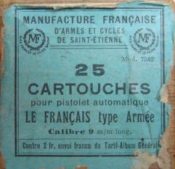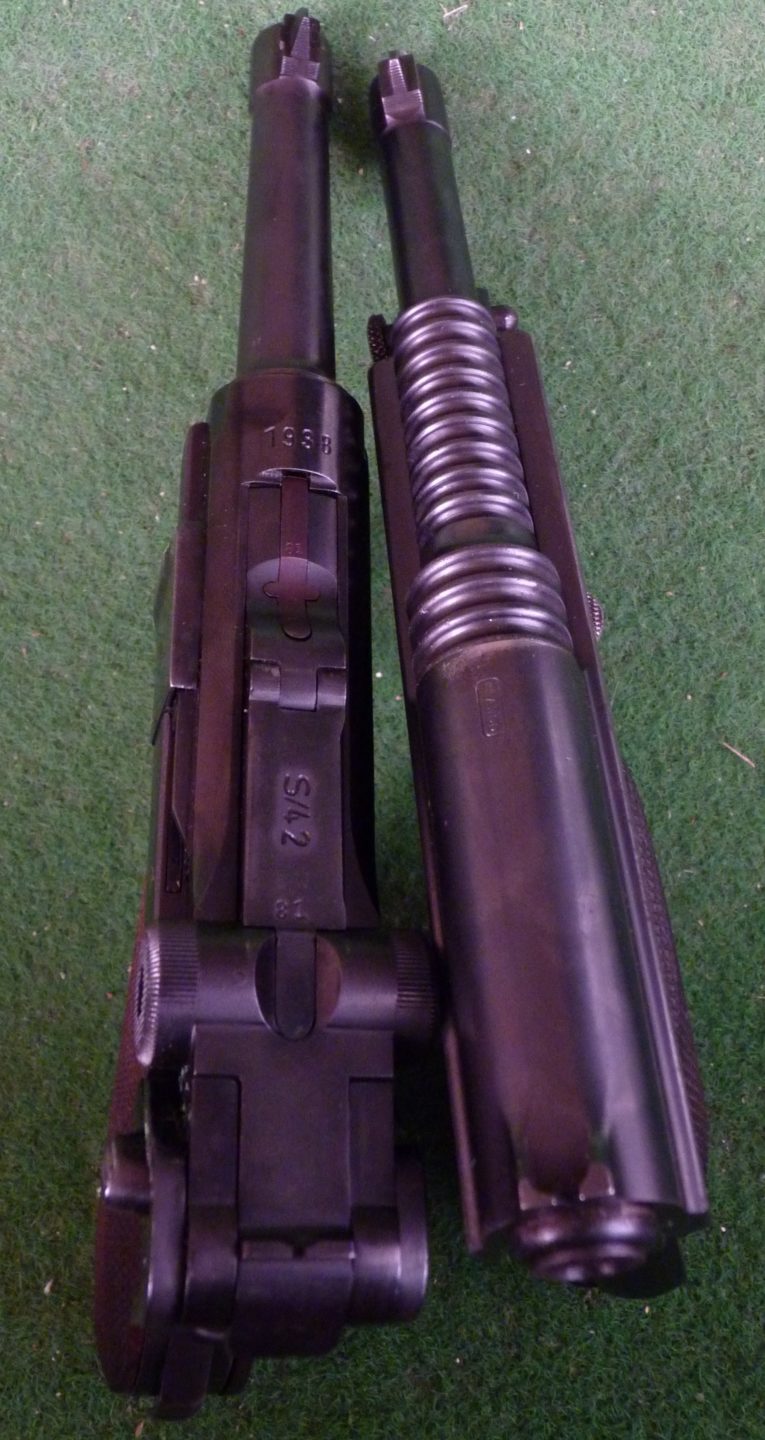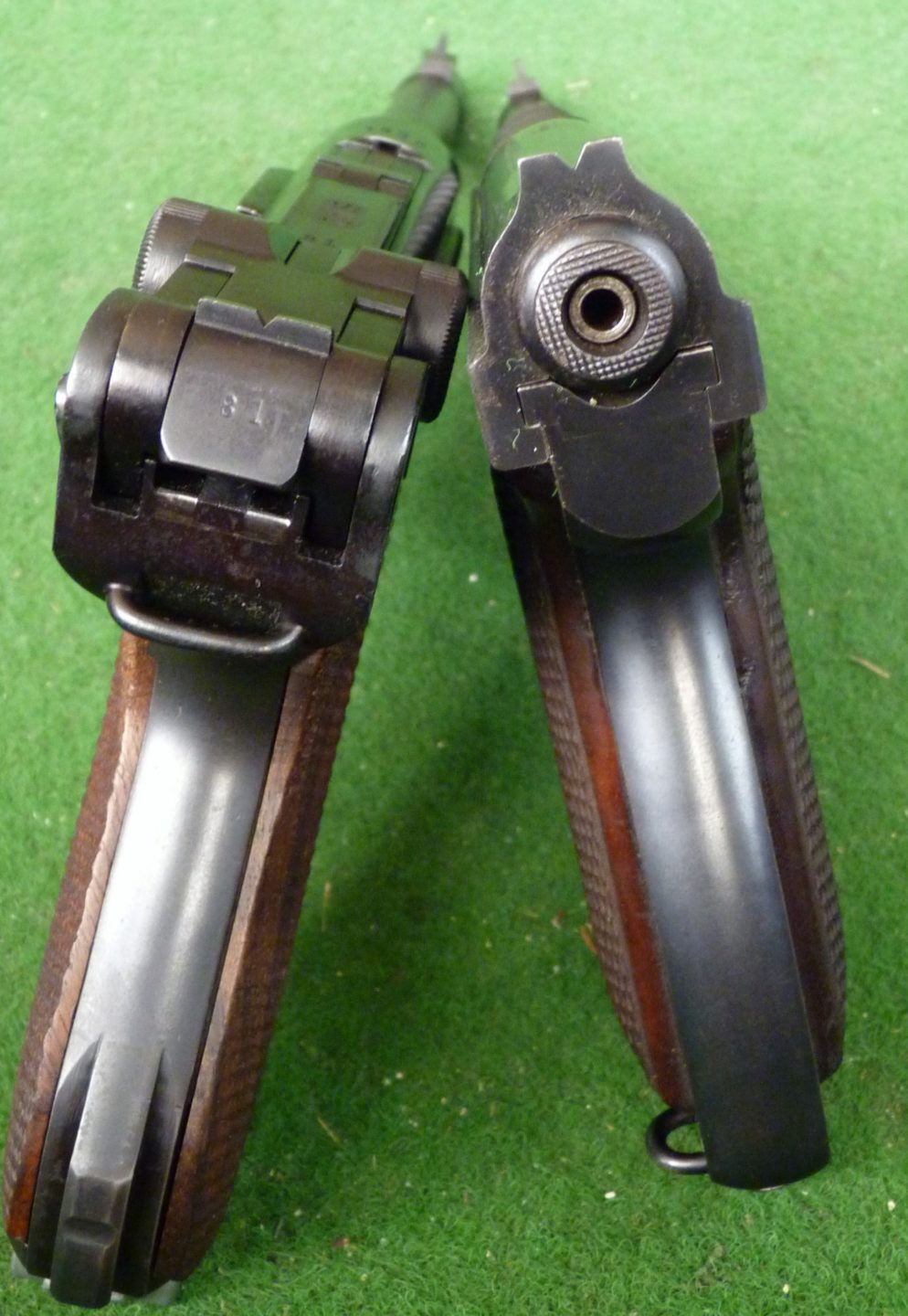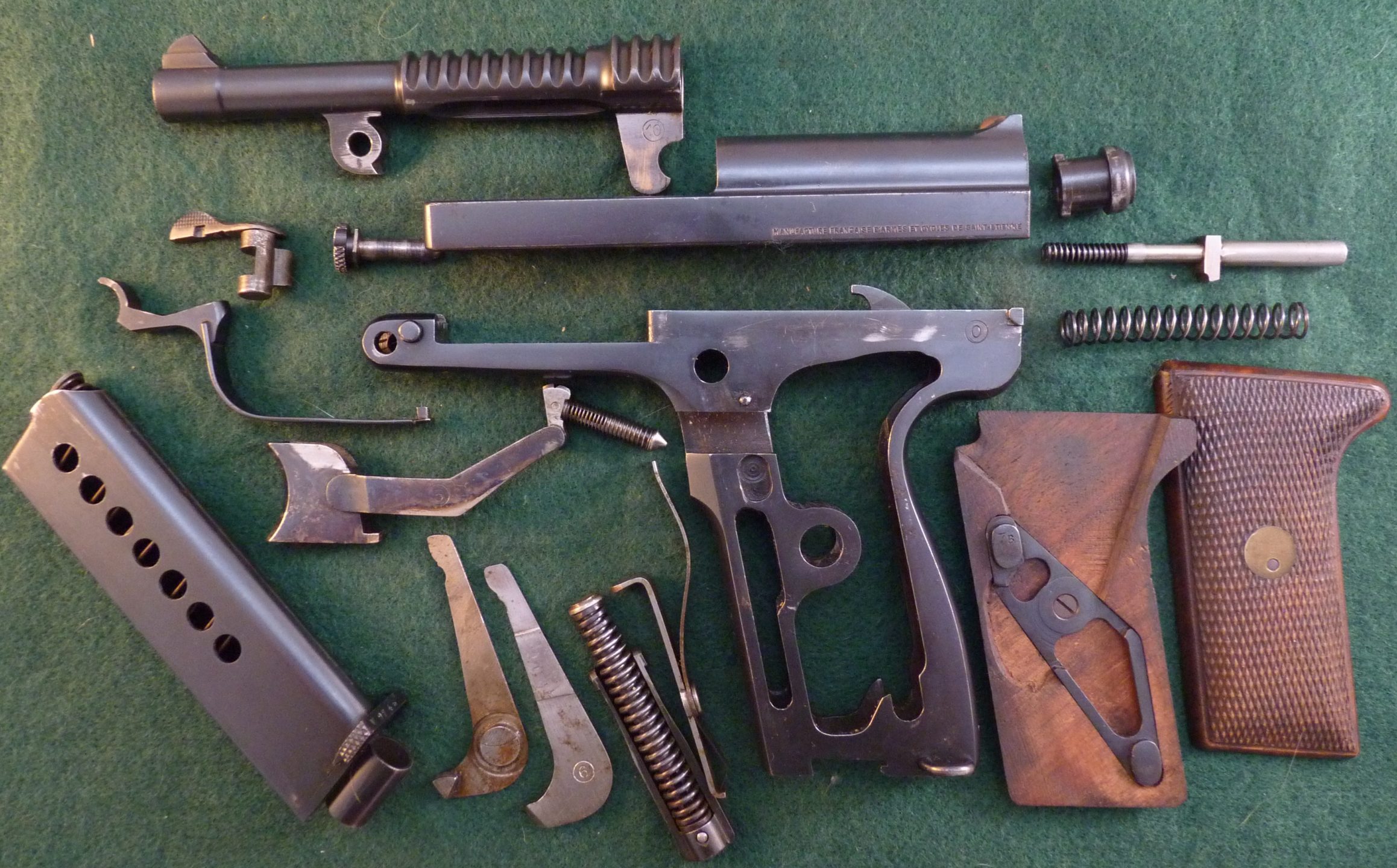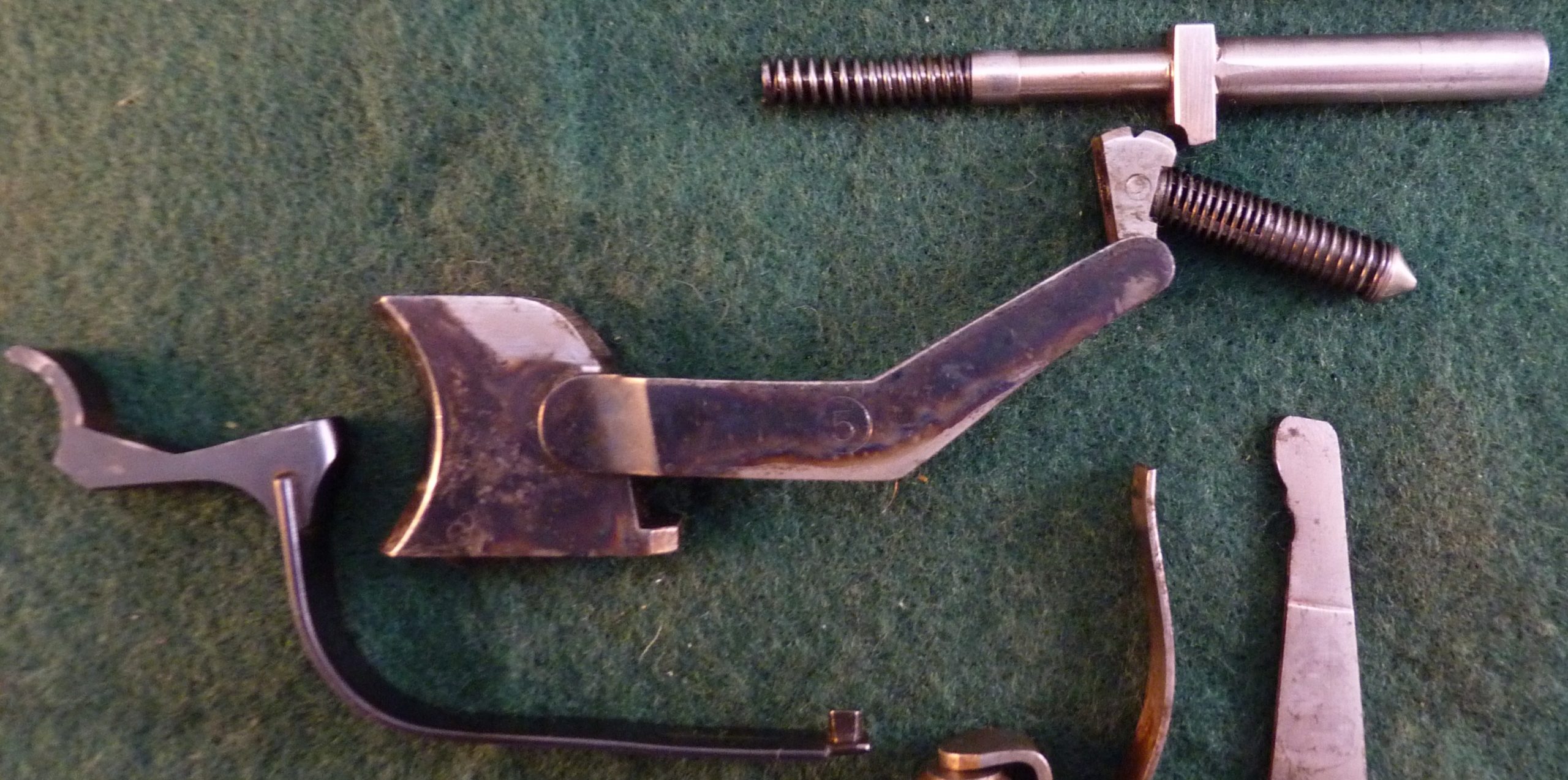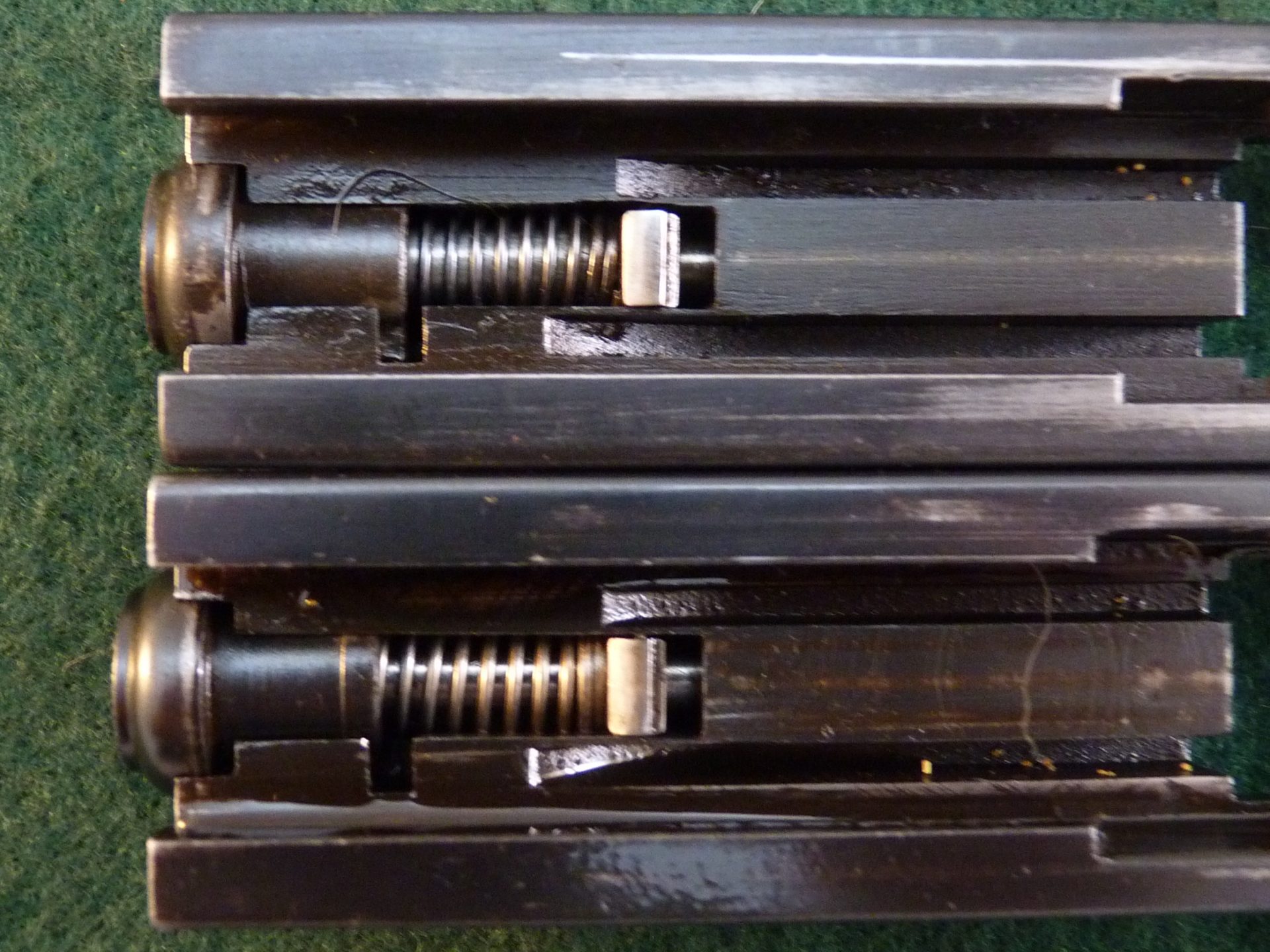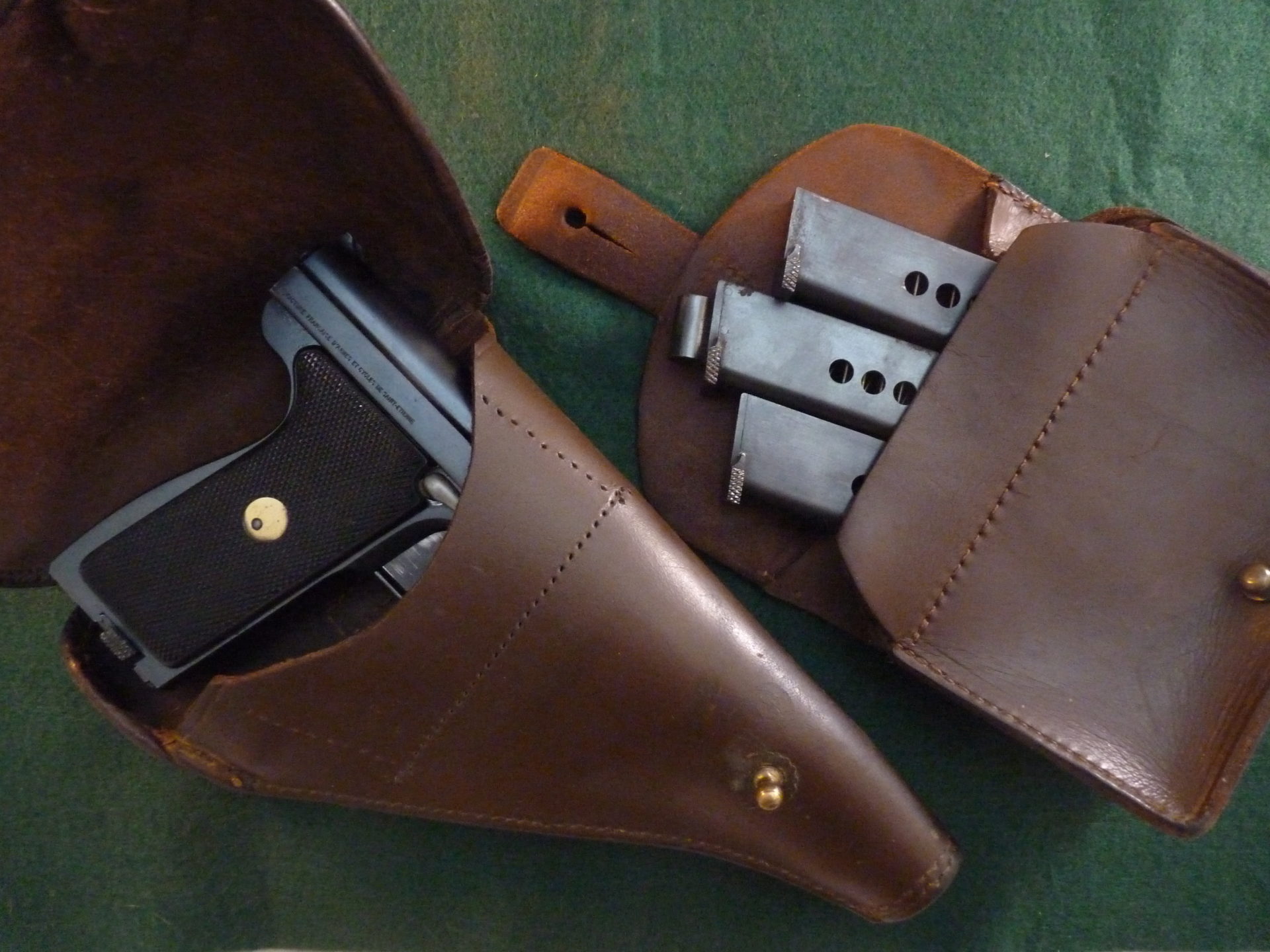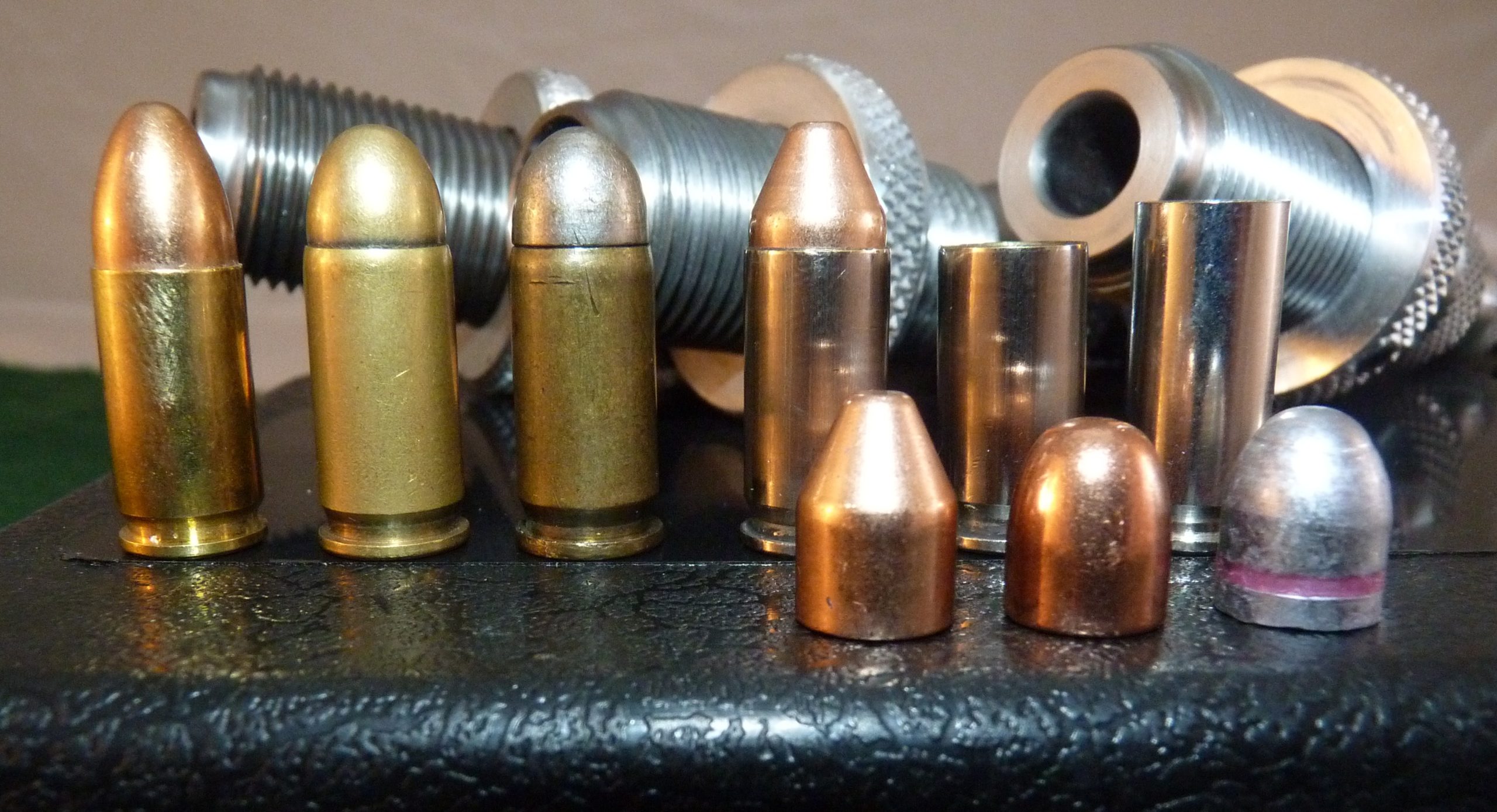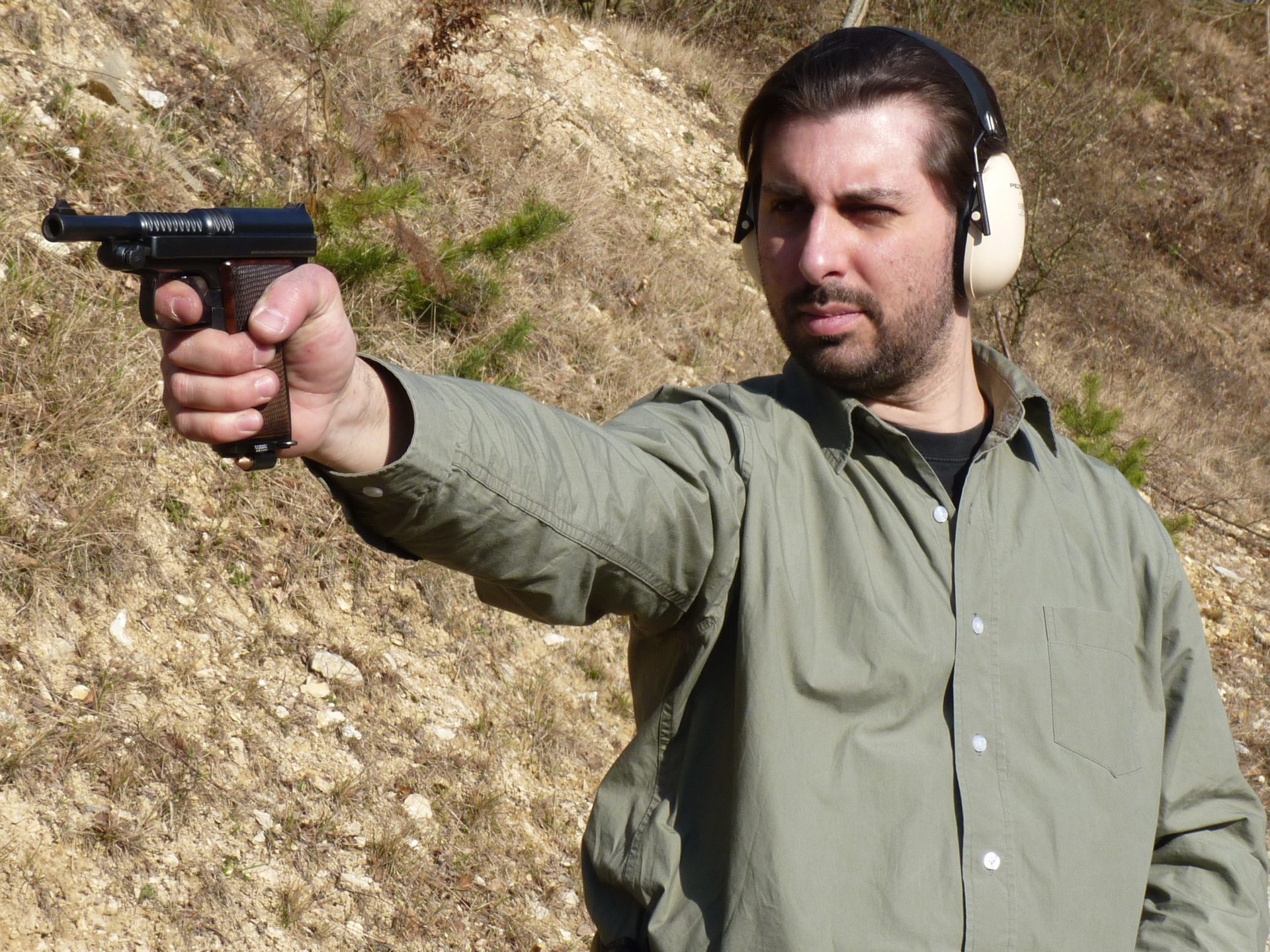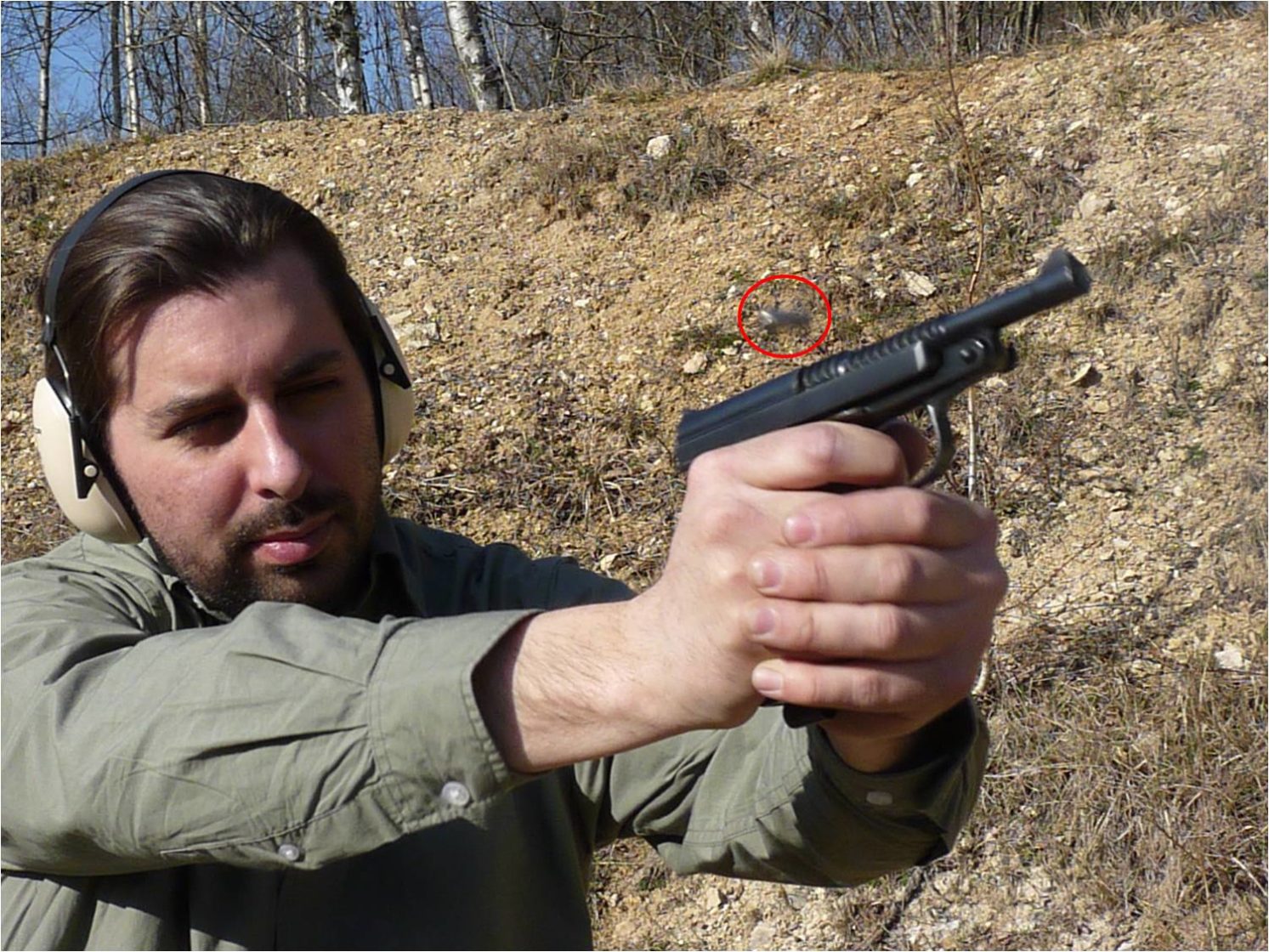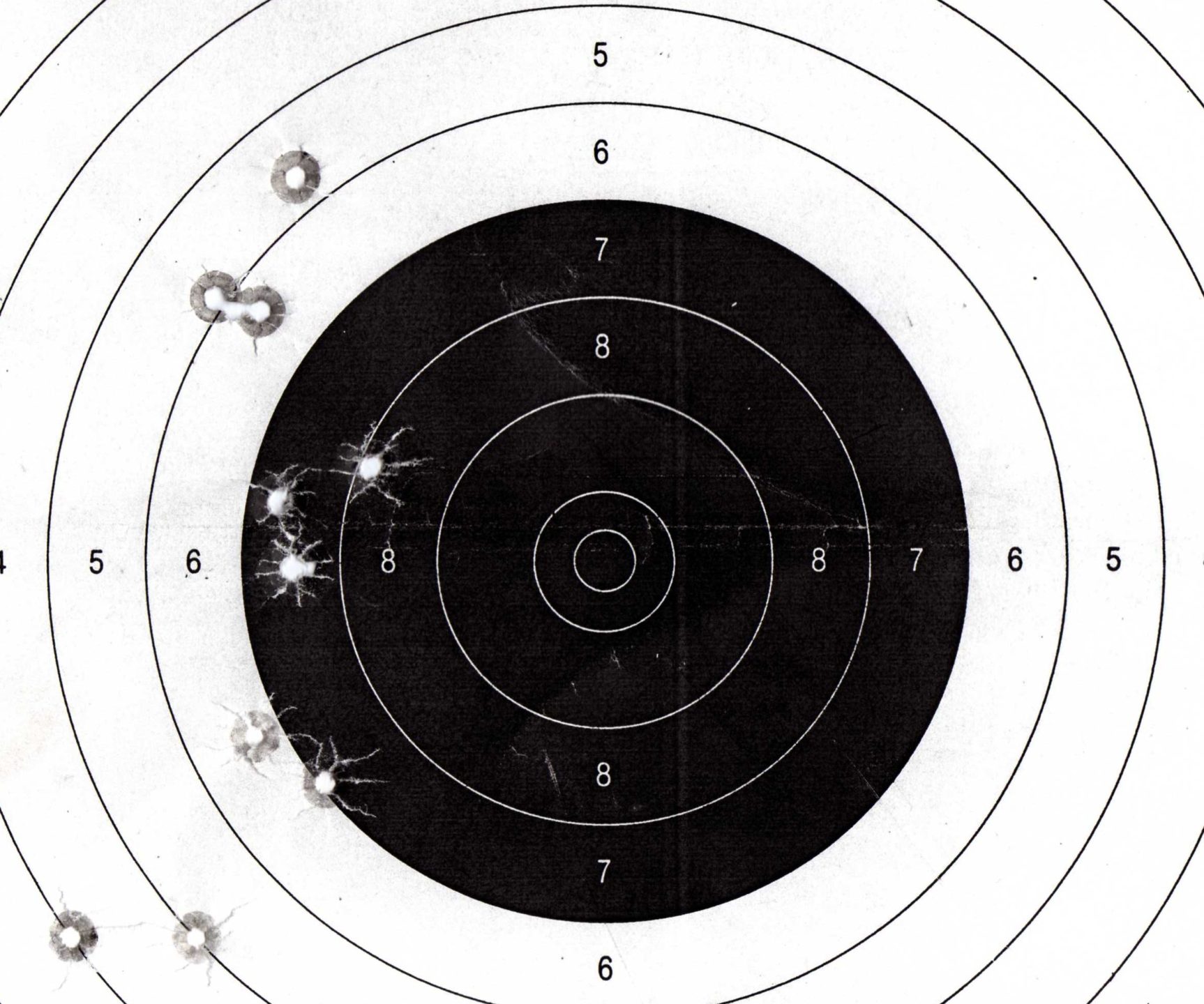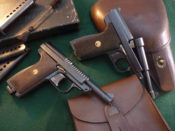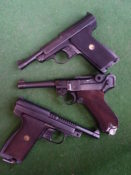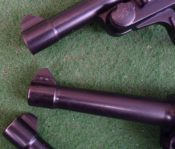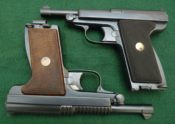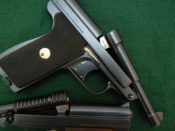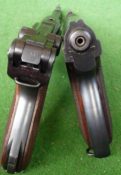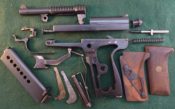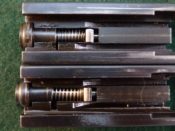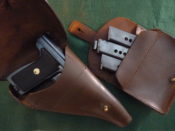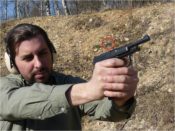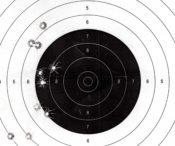« Le Français Type Armée » Pistol in 9mm Browning Long

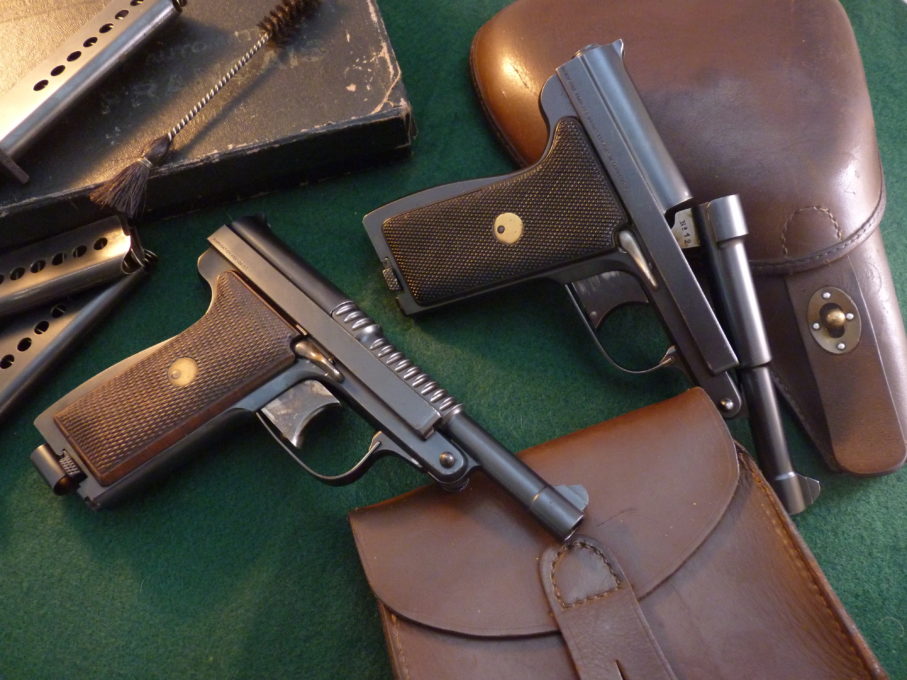
At the end of WWI, the military authorities reviewed the state of armaments within the forces. Major development programs were then implemented in heavy armaments, communications and transport. Individual armament was not to be outdone and would know an effervescence from the beginning of the 1920s. Development programs included an infantry rifle, a light machine gun, a semi-automatic pistol, a submachine gunSubMachine Gun More and two new calibers. These programs would result in two emblematic weapons and a caliber, the MAS 1936 rifle, the 1924 M29 LMG and the cartridge of 7.5×54 mm.
Many manufacturers usually position their productions or prototypes with evaluation commissions. National manufactures such as Saint-Étienne, Tulles or Châtellerault position themselves against private companies such as Browning, SACM, or, in the example that interests us, the Manufacture d’Armes et Cycles de Saint-Étienne. The latter will offer in 1928 a semi-automatic pistol particularly original and innovative. This weapon would be refused twice by the Commission d’Évaluation (TN: evaluation commission), but it would become one of the most coveted pistols of French weapons collectors!
The Manufacture d’Armes et Cycles de Saint Étienne
In our article on the revolver “L’Africain” we mentioned the creation of this great House of the French gunsmithing. This company quickly achieved commercial success, by putting on the market weapons that were efficient and fit customer’s expectations. We can mention the various Buffalo rifles from 1885, the famous and highly sought-after rifle “L’Idéal” from 1887, the manual repeating pistol or “pocket machine gun” “Le Gaulois”. The complete list of innovations and successes of “La Manu” is too important to mention in an article, many books being devoted to very relevant studies on these productions.
At the beginning of the twentieth century, “La Manu” had already acquired commercial notoriety, providing a considerable number of pieces. Some were weapons developed and designed by the company, others were unmarked weapons bought mainly in Belgium and then rebranded with the logos and brands of “La Manu”. At the beginning of this century, technical advances were as numerous as they were fast paced. Semi-automatic pistols were becoming more reliable and affordable, taking an increasingly large share in the civilian armament market. “La Manu”, after having been at the forefront of innovation, was lagging far behind in this area. Its range of handguns consisted mainly of revolvers, manual repeating pistols and a few imported semi-automatic pistols. No innovative handguns of original design were present in the catalog. Self-aware of this weakness, it developed a semi-automatic pistol which it wanted to be simple, innovative and reliable. On August 6th, 1913, the first patent relating to the realization of the pistol “Le Français” would be registered. This weapon would arrive late on the market and would be mainly marketed after WWI.
Without looking back on the history of this glorious “Le Français” pistol, which would have a career as rich as it was long and which would be declined in many models, it is worth recalling its basic functionalities. In order to distinguish itself from the competition, specifications included the following points:
- Operations must be as simple, reliable and safe as on a revolver. The weapon must not require slide operations, once loaded it must be ready to fire. The weapon must have no active or passive safety.
- The pistol must not be able to be used without a magazine, it must not be possible to feed it and fire a cartridge without the latter in place, the barrel being disengaged on its axis.
- The weapon must not have parts or springs permanently under tension to limit wear and the risks associated with a failure. All the springs of the weapon are therefore at rest, the action of cocking the firing pin being related to the pressure on the trigger.
- Finally, the weapon must be easily disassembled, without the use of specific tools.
I like to pull the leg of my shooting range colleagues that own Glocks, by telling them that their weapons are clones of “Le Français” system developed 70 years earlier but obviously the comparison ends here…
These small pistols would be a great success, due as much to their quality of realization as to their irreproachable operation. The last models would be produced by MANUFRANCE (new commercial entity of the Manufacture d’Armes et Cycle de Saint-Étienne after 1945) until 1968 for the Policeman model. In France, they would be mainly intended for personal defense, acquired before WWII with relative freedom, or after with defense detention. Most of these weapons have never fired any cartridge and rarely left their owner’s drawers.
The “Type Armée” pistol
Convinced that it had developed the most compatible weapon at the request of the army, combining the simplicity and reliability of the revolver with the ability and speed of the pistol, “La Manu” quickly started the tests of evaluations of handguns for the French army. On June 5th, 1928, a copy was entrusted to the technical section of the artillery. Several pistols of this type would be tested by the Versailles commission of experiment, between November 6th, 1928, and February 17th, 1933, in seven series of tests.
As the advertisement on the 1930 catalogue album indicates:
“Our automatic pistol LE FRANÇAIS TYPE ARMÉE was established to meet all the requirements of a weapon of this kind intended for military personnel. It is never cocked and can therefore be held in hand, without the slightest danger, by a galloping rider or an officer at the gym pace… ».
In a period of transition, this weapon was intended to be the synthesis of the advantages of modern revolvers and pistols. It is always difficult to study the exact causes of rejection of a weapon to military criteria, the reasons can clearly be objective, but sometimes more obscure. In this case, the most striking points that may explain the out-of-competition of this model are, on the one hand, the double actionThe "double action" is a trigger mechanism where the action ... More only (DAO) trigger mechanism and on the other hand the absence of an extractor. The DAO does not favor precision shooting, the relatively long trigger travel can slow down the rate of fire. As for the extractor it is considered essential on a duty handgun. We will see later in the review that these points were far from constituting real flaws for civilian use. The ammunition certainly did not work in favor of our weapon. The 9mm Browning Long (official name given by the CIP), was not even at the time a cartridge of wide distribution, with even less ballistic qualities than the 9x19mm Parabellum. Another point to emphasize, as early as the 1930s, the choice of military caliber had already been clearly oriented in favor of the 7.65 Long by the Versailles Commission.
This pistol was used by some officers who personally acquired it. The majority were sold on the civilian market and truth to be said, would see very little use. The models that have reached us in firing condition are for the most part in a like new condition. Some copies have certainly left the territory for one of the colonies of Asia or Africa.
The variations: first and second model
The weapon had essentially two versions in its short career. The first successful model was characterized by a barrel without external grooves, the wooden grips were quickly replaced by checkered ebonite grips. These grips are fixed to the frame by a rotating metal piece. A venting hole was also drilled on the slide, above the percussion channel. It allows, if necessary, to evacuate the gases related to a rupture of the base of the ammunition. The first magazine is directly copied from the pistol “Le Français numéro 1” in 6.35 Browning.
The main evolution that characterizes the second model appeared in 1931. The barrel had external grooves in order to lighten it. The grips were again made of wood, fixed on a metal sheet. The magazine adopted a ring intended to carry an ammunition at its end. This ring had a spring ensuring the retention of the cartridge once in place, so a cartridge is quickly available to supply the gun chamber and make it ready to fire.
As for the other weapons sold by the Manufactures d’Armes et Cycles de Saint-Étienne, several finishes were available, from the classic «war» finish to luxurious finish with engravings and precision adjustments. The number of weapons produced is not known precisely due to lack of archives. Some authors estimate this number at less than 5 000 copies, all versions combined while others evoke a production close to double that number. Anyway, this weapon remained very confidential in its time, and today represents a piece of choice in a collection. The production of the “Type Armée” ended in the mid-1930s.
If the manufacture of this gun was entirely the result of the Manufactures d’Armes et Cycles de Saint-Étienne, we can distinguish two distribution circuits. The first, classic, distributing these weapons and accessories via the network of branches of “La Manu”. A second distribution network had been created to distribute these products to wholesalers and professionals, “La Manu Modèle”. The identification of these models was simple, the markings and labels being different:
- On the model of La Manufacture d’Armes et Cycles de Saint-Étienne: on the right flank “Manufacture Française d’Armes et Cycles”, on the left flank “Type Armée”, on the top of the slide “Le Français”.
- On “La Manu Modèle” models: on the right side “Fabrication Française”, on the left flank “Manufacture Française d’Armes et Cycles”, on the top of the slide “Franco”.
An original operation
The weapon operates from a blowback, the ammunition fits this mode of operation in a handgun. Without being locked, it is necessary to emphasize the power of the recoil spring which is considerable for this type of weapon. It is almost impossible to cock the weapon by operating the slide. Note that no notice provides for this operation, the feeding being made directly via the chamber. Note that the weapon is not equipped with a slide stop. At the end of the cycle, the slide closes on an empty chamber. It is therefore not possible to mechanically hold the slide in the rear position. Models produced later in 7.65 Browning would overcome these “flaws”. The slide will remain open after the last shot, the magazine holding it open via its follower. The slide will also be designed with external grooves to facilitate a more conventional armament.
A crucial design of our weapon: the barrel is tilting. As soon as the magazine is removed, it rotates on its axis, freeing the chamber and putting the weapon on safety. It is also possible to tilt the barrel by operating a lever on the right side of the weapon, in order to replace a failed ammunition or unload the weapon. This process is not unprecedented, since it appeared in 1908 on a Steyr pistol and on a Piepper pistol. Other weapons would successfully adopt this tilting barrel, such as the Beretta model 950 or the Taurus PT22 pistol.
As on a Webley & Scott pistol, the weapon is equipped with a vertical recoil spring, which is a particularly original arrangement! The recoil spring is captive to a fairing and located in the pistol grip. This spring transmits its energy via two brackets positioned on each side of the frame. These brackets are mobile on an axis and allow the translation of the slide. Also note that the difference in the length of the brackets generates a multiplication of the travel but also of the momentum of the slide in relation to the spring. Indeed, the brackets acting on the slide are larger than those in contact with the spring, which induces a mechanical advantage in favor of the slide. If the multiplication of the travel is undoubtedly a desired effect to integrate the spring from a geometric point of view, the multiplication of the momentum is probably an induced effect.
The action on the trigger, which is attached to the transmission bar, acts directly on the sear that cocks the firing pin. The latter recoils on its spring and at the end of its travel, the sear lowers under the effect of an inclined ramp and releases the firing pin. When the sear releases the firing pin, the sears springs puts it back in place in order to catch the firing pin as the slide ends its cycle. To ensure the second shot, it is necessary to release the trigger and reproduce the same action. There is no pre-armament, the resistance on the trigger is identical from the first to the last cartridge. We are indeed in the presence of a “strike-fire” in double actionThe "double action" is a trigger mechanism where the action ... More only.
Specifics of the “Type Armée” pistol
The “Type Armée” pistol is an extrapolation of existing models in 6.35 and 7.65 Browning calibers. The dimensions of the weapon have been revised in proportion to the new ammunition. It is interesting to highlight this work, which is particularly delicate, it is indeed from our point of view simpler to reduce a weapon than to increase its dimensions. Details were added to this model in order to strengthen the military character, appearance of a lanyard loop, more rustic bluingSurface finishing of steel giving a black (sometimes bluish)... More, wider sights. Some points are also reminiscent of other weapons, such as the reinforcement at the end of the barrel copied from the Luger P08 pistol.
As previously mentioned, the weapon has no safety, neither active nor passive. The operation is therefore very close to the philosophy of the revolver. Note that there is no risk of accidental percussion when the weapon is at rest (except from breakage of part): the firing pin is almost not under tension, and its notch is immobilized by the sear. This last point is presented as one of the three “safety” of the “safe-action” of Glock pistols. Operation is simple. At first, engage a magazine in the gun. It is then possible to put ammunition in the chamber and lock the barrel. To unload the weapon, simply remove the magazine and empty the chamber from the barrel that is automatically tilted. It is also possible to unlock the barrel first and then extract the magazine.
Complete disassembly without tools
The strong point of our weapon is to be fully disassembled and without tools. As with the 1892 Revolver d’ordonnance, the parts are numbered to facilitate disassembly and reassembly operations.
First, ensure that the weapon is not locked and loaded. Remove the magazine. The barrel automatically tilts, exposing the chamber. If there is a cartridge, remove it by hand. At the front left of the gun, rotate the lock by making the notch coincide with the screw. While maintaining pressure on the front part of the barrel, remove the pin. This operation must be carried out with caution, the trigger guard acting as a spring may expel the barrel forward. Pull the trigger guard forward and take it out of its position. To extract the slide, lift the front of it and pull the whole thing forward. At this point it is possible to take out the trigger mechanism. With the thumb, press the slide cap by making a quarter turn clockwise: the cap separates from the slide. Hold it firmly while extracting the firing pin and the two springs.
The handgrips are extracted from the frame by pushing them upwards. To extract the brackets and disconnect the recoil spring, the weapon must be positioned on a flat and rigid support, such as a wooden workbench. Grasping the frame firmly, press the base of the recoil spring on a hard ground. By compressing the latter, the two brackets are released and are removed without resistance. The recoil spring and retention spring assembly is extracted from below. The trigger is extracted from the front. The barrel locking lever is pulled out from the right. These operations only took a few minutes. The reassembly is carried out the same way in reverse by taking particular attention to the reassembly of the spring acting on the barrel locking lever and on the translation brackets.
Like any system, it is possible to bypass technical devices. It is indeed possible to shoot without a magazine. It may seem useless, but magazines are rare, expensive and it should not be ruled out that a shooter does not have them (or forgets them at home). The technique is simple, when reassembling, a leaf spring is inserted into the barrel locking lever. Its action is to push this lever down and precisely not to allow the locking of the barrel in the absence of the magazine. It is possible not to insert this leaf spring into the lever, but by pressing on its back part. The action is reversed, and the lever is held in the locking position, even in the absence of a magazine. Regarding the safety of the weapon, it is possible to prevent percussion. It is simple when reassembling the weapon only position the notch of the firing pin in the high position, reversing the direction of reassembly. While in its lug, the trigger no longer has a connection with the firing pin, so the weapon is temporarily neutralized. Of course, the firing pin doesn’t protude into the bolt faceThe bolt face is the part of the bolt which in set place the... More.
A rare ammunition, the 9mm Browning Long
This cartridge is as its name suggests the work of John Moses Browning. It is also sometimes called 9x20mm SR Browning Long (SR = Semi-Rimmed). It was specifically developed for the Browning 1903 pistol. This ammunition was the unfortunate competitor of the 9x19mm Parabellum, which was more efficient and more widely spread on the market. The 9mm Browning Long would still be adopted by regulation in 1907 by Sweden. There are only three weapons chambered for this cartridge, which perfectly illustrates its “confidentiality”: the Browning 1903, the Webley & Scott model 1909 and our pistol Le Français Type Armée. This ammunition would never know a real commercial diffusion and would remain one of the rarest 9mm cartridges.
This cartridge is far from possessing the qualities and performance of other 9mm ammunition developed at the same time. It displays only an acceptable pressure of 1800 bar and an advertised speed of 320 meters per second. For comparison, the 9x19mm Parabellum has a permissible pressure of 2600 bar for a speed of up to 370 meters per second. The case is almost cylindrical, with a length of 20.20mm. Its base is semi-rimmed. The groove diameter is 9.09mm. The various advertisements of the time gave optimistic characteristics for this ammunition:
“At 50 meters from the muzzle of the barrel the bullet crosses 6 to 7 pine boards 20mm thick distant of 30mm from each other “.
The French author René Malfatti, a specialist in reloading, has described this ammunition in several of his books and brought to the amateurs that we are, the basic elements of reloading. I invite French reloaders to consult his publications, which are still a reference in this area today.
In the first place, since this caliber is little or not used by the common shooter, there is no need to waste time looking for components or ammunition on the market. From time to time by chance of an announcement, ammunition at very high prices and of old manufacture can be found. The latter should be considered only for the collection. The most frequent on the French market are our national cartridges, Gévelot and SFM. The reproduction of this ammunition is made possible by the modification of modern brass. The technique consists of modifying .38 Super Auto or .38 ACP brass (not to be confused with the .380 ACP which is 9mm Browning Short) by shortening them. It will still be necessary to check the production tolerances, but most of the brass are compatible. For our part, we used as a starting brass the .38 Super Auto nickel-plated from Remington.
The bullets are also available on the market, often on special order. Weighing less than 9x19mm Parabellum, they must be selected between 5.84g and 6.48g. The bullets of the 9mm Browning Short are particularly suitable. In this review, we used three bullets, a 102 grain lead bullet from the Lee reference 356-102-1R mold and two FMJA bullet with a metal core (usually lead, sometimes with a m... More bullets: one 90 grain round nose and one 100 grain truncated cone both from Fiocchi. These bullets are in a diameter of .356 inch.
In the SNPE range, two powders are particularly suitable: the A1 and Ba9. They offer good versatility and an interesting recharging density. The Ba9 is more flexible to use but requires a greater crimping than the A1. Concerning the elaboration of the loads, I refer the readers to the works of René Malfatti. Particular attention must be paid to the progressive calibration of the load, but also to the volume capacity of the brass. We have already had the opportunity to address this principle, namely that each brand of brass has different volumetric capacities. It is important to consider this information before using a load.
Few manufacturers of reloading dies have the 9mm Browning Long in their catalog. This caliber being very confidential, it is systematically classified in the rare die sets, “limited” and therefore expensive. It is empirically possible to use the die of the 9x19mm Parabellum with ad hoc adjustment, but it is so much simpler and more effective to own a set of dies to the caliber. I personally like the dies of the American brand CH4D, reliable precise and economical. This time again it is in their production that I found what I looked for. I would like to salute the kindness and availability of the commercial managers of this company, always ready to provide advice or information. The dieset is presented in the most traditional way with 3 dies. The shell holder for our cartridge is very tightly sized, since even the SFM and Gévelot cartridges cannot fit into it. It is appropriate to complete our set with a shellholder of .38 Super Auto.
A classic reload
The brass is obtained by shortening it with the trimmer box to the length of 20.20mm. The rest of the operations are totally conventional. It is necessary to emphasize the importance of crimping which without being excessive must be quite firm.
These uncommon weapons on our firing range have long had a reputation for being inaccurate, fragile and unreliable. It is clear that this is not the case for civilian use! These pistols are massive, the weight is consistent with a weapon of this category. The balance and grip are excellent. The handgrip is almost at right angles, it is very correctly sized and allows a firm and precise support when shooting. The distance between the index finger and the trigger is correct for a shooter with medium-sized hands. Aiming is instinctive, characteristic of a good combat weapon. The sights are, alas, from another era. Already outdated when they were developed from the gun, these sights do not allow constant targeting. The front sights of good proportion are reminiscent of that of the Luger P08. Machined in the mass it has anti-reflective grooves on its front face. The rear sight is also machined in the mass, unfortunately the target notch is in “V” or exactly the opposite of the front sight.
Feeding the magazine is simple and flexible up to the last cartridge. Of exemplary finish, the magazine is clearly intended to last over time. This element is now increasingly used as a consumable, which is regrettable. The cartridge is introduced manually in the chamber, then the barrel is returned to the firing position. There is no gap, the adjustment is perfect!
The first shots were deliberately carried out at close range, in order to understand the operation of the weapon and the control of trigger release. The sensations are very peculiar and require to getting familiar with both the trigger pull weight, the travel of the trigger and to its horizontal sliding. Being used to DAO revolvers, I find the same sensations and the same attentions. The weapon must indeed be firmly handled with a constant pressure of the thumb on the left plate. The trigger pull weight is identical from the first to the last cartridge, the action being constant, without pre-arming the firing pin. After a travel of about 8mm, the shooter feels a hard point that immediately precedes the shot. This resistance occurs when the trigger will release the firing pin. It is therefore possible to control the trigger release and focus on its aim. Note that the trigger moves only on a horizontal plane, which is unusual to say the least on a double-action only weapon. During instinctive shooting, we no longer perceive this resistance. The shots are carried out rapidly. We made a speed comparison between our pistol and a recently manufactured revolver in .38 Special. At the same capacity, the firepower is similar.
Once the release is mastered, the weapon makes it possible to obtain satisfactory results and to get real pleasure in shooting. First positive point, the weapon shoots center hold sight! As mentioned, the sights are machined in the mass, which shows a particular care during the realization of the weapon. The recoil is very dry, and sometimes unpleasant with some of our reloading. Let’s not forget that the slide is not locked. It will be suitable for regular use to determine the most flexible load possible: our choice stopped at the Ba9 allowing a good compromise between volume and shooting sensation. Our cartridges display speeds between 230 and 240 meters per second. On the other hand, it is important to select the primers used. To be very clear the weapon cannot stand too hard primers that inevitably result in percussion failures. After several tests, we chose only the Winchester and Federal brands ensuring total reliability.
The ejection is regular, something rather surprising for a weapon without an extractor. The brass touch the ground in a circle of 30cm at 4 o’clock. These are neither marked nor deformed, except for the last case which has an unfortunate tendency to get stuck between the slide and the barrel. The pictures taken highlight the cycle of the system: the case only traveled a few centimeters before the slide was back in the firing position! This speed is explained by the fact that the slide is not locked at all.
Although this is not its vocation, we took a lot of pleasure in using these pistols on metal gongs positioned at 7m in rapid fire. The hit probabilities are then very close to those of a modern revolver.
To conclude
These weapons pleasantly surprised us, both by their reliability of operation and by the relative accuracy of the shots. Far from the small pistols of the same family, the “Type Armée” pistol is exploitable for target shooting. Don’t be fooled though, this is not a competitive weapon! Rare on the market, it is considered by many collectors as a landmark piece of the armament of the early twentieth century. The models illustrating this review come from two well-known gunsmiths. Note that these pistols unfortunately remain classified in category B-1. We can hope that future French legislation will consider their scarcity and obsolescence as a criterion for decommissioning.
Julien Lucot
This is free access work: the only way to support us is to share this content and subscribe. In addition to a full access to our production, subscription is a wonderful way to support our approach, from enthusiasts to enthusiasts!
Thanks
François and Ludivine for their help and assistance
Gilles Sigro gunsmith in Toulouse http://www.ateliersaintetienne31.fr
Alain Robert at James gunsmith in Autun http://www.james-autun.com
Sources
Gazette des armes issue #139 March 1985 Paul Régnier
Gazette des armes issue #258 September 1995 Luc Guillou
Gazette des armes issue #436 November 2011 Henri Vuillemin
Cibles issue #502 Raymond Caranta
Frederic Delvolte http://armesfrancaises.free.fr
Data
Manufacturer : Manufacture d’Armes et Cycles de Saint-Étienne
Models: 1928 and 1931
Weapon length: 202mm
Barrel length: 128mm
Line of sight length: 190mm
Height: 130mm
Weight, empty: 1040g (first model), 900g (second model)
Capacity: 7 cartridges + 1 in the chamber
Operating mode: Semi-automatic, blowback
Trigger mechanism: Double actionThe "double action" is a trigger mechanism where the action ... More only
Caliber: 9mm Browning Long
Legislation: B-1 (French legislation)


